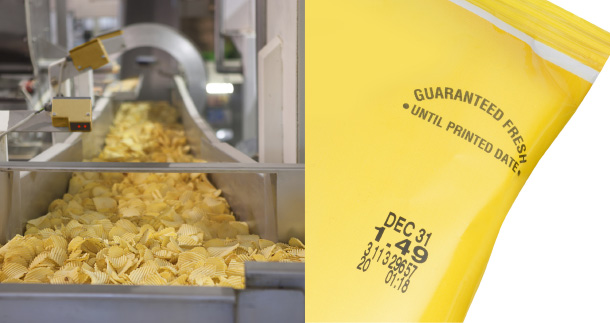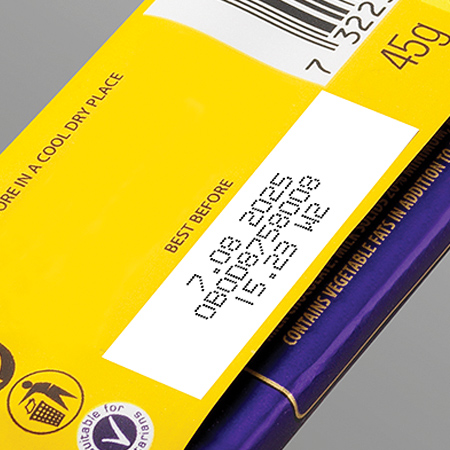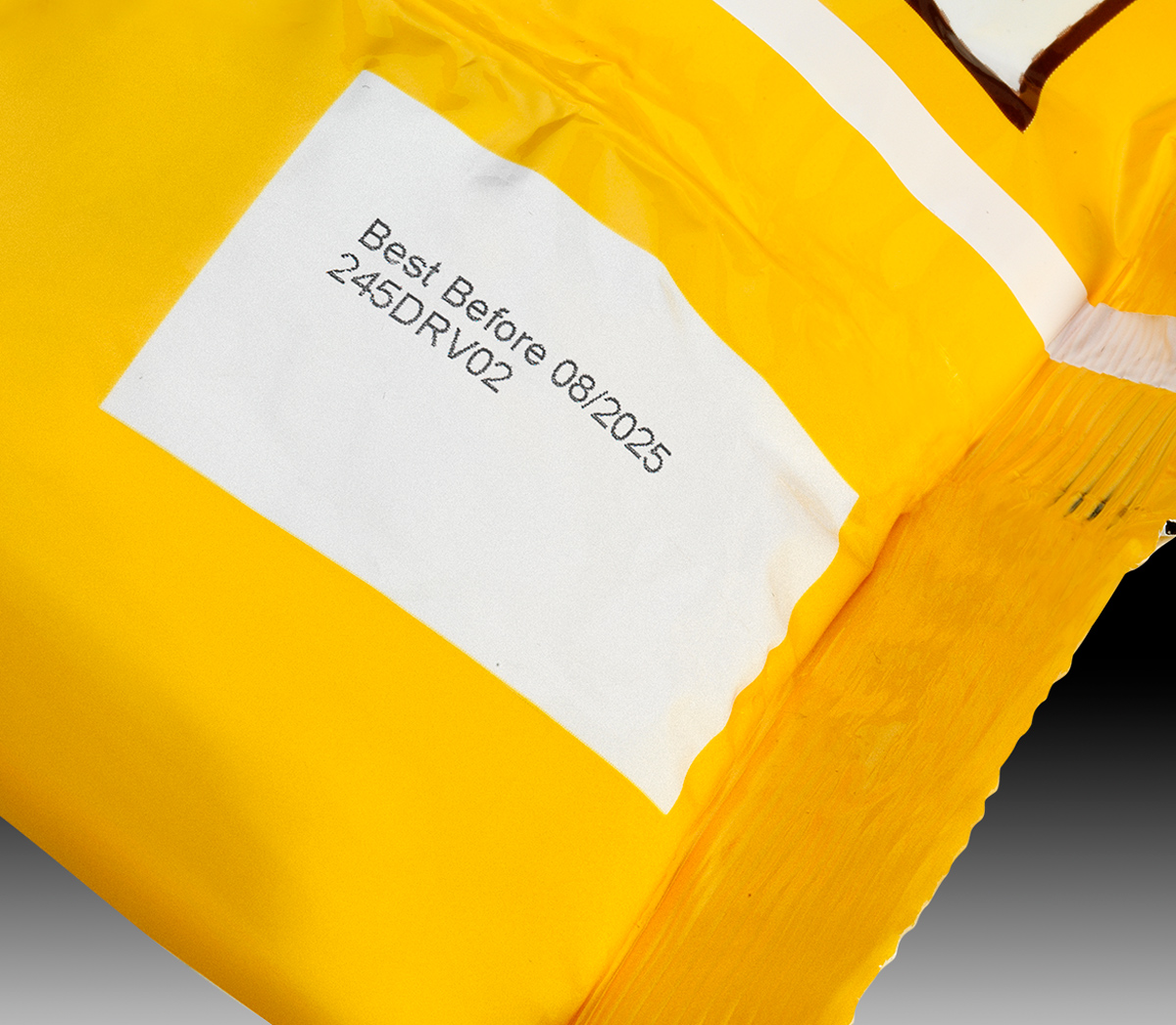Imagine this: A major food manufacturer is in the middle of a massive product recall. The reason? A batch of products was shipped with incorrect expiration dates, leading to potential health risks for consumers and a significant hit to the company’s reputation. This scenario, while hypothetical, highlights a very real risk that manufacturers face every day—poor coding on flexible film packaging. This underscores the critical importance of accurate and reliable coding on flexible film packaging to support product safety and compliance.

What is flexible film packaging?
Flexible film refers to a type of packaging made from pliable materials that can easily change shape. These lightweight materials include plastics, like low-density polyethylene (LDPE), and other versatile materials such as Polyethylene Terephthalate (PET), Polypropylene (PP), and flexible metallized films. These materials are widely used for packaging candy and snacks, medical supplies, consumer goods, agricultural products, and industrial products. The flexibility of these films allows for innovative packaging designs that enhance product appeal and functionality.
Mono-materials: Paving the way for sustainable packaging
Mono-materials are transforming packaging by providing a sustainable alternative to traditional flexible films, which often complicate recycling. Made from a single substrate like PE or PP, they may also have a very thin but high-performance barrier layer for product longevity that doesn’t hinder recyclability of the packaging. Designed to fit into existing recycling systems, they promote a circular economy and can reduce waste. By educating consumers on proper disposal, mono-materials can contribute to the advancement of a circular economy.
What are the advantages of flexible film packaging?
Flexible film packaging offers several advantages:
- Cost-effective: Flexible film is much lighter than rigid packaging, helping to reduce transportation costs and environmental impact.
- Durability: Flexible films provide excellent protection against moisture, oxygen, and other contaminants, preserving product quality.
- Versatility: Flexible films can be used for a wide range of products, from food and beverages to pharmaceuticals and electronics.
- Customizability: Flexible film can enhance product perception. Innovative and functional designs stand out on retail shelves, engaging customers with eye-catching visual appeal.
Choosing the right marking technology for flexible films

Advanced coding technology is engineered to deliver high performance on a multitude of substrates. Whether polyethylene, polypropylene, or any other flexible packaging material, today’s printers and lasers produce sharp, readable, and long-lasting codes.
1. Advanced laser marking solutions for flexible film packaging
Advances in both laser technologies and film composition make laser an excellent choice for precise date, lot code, 2D barcodes, and allergen info marking. UV lasers induce color changes on UV-reactive films for permanent, high-resolution coding. Fiber lasers are ideal for high-contrast coding at ultra-fast speeds and getting crisp permanent marks on flexible film and foil. These ink-free solutions can help reduce operational waste, offering advantages to both business and the environment.
UV laser marking systems like the Videojet 7920 incorporate cutting-edge technology to significantly reduce setup times. Its SmartFocus™ feature streamlines the process by automatically adjusting the focus distance to a distance predetermined during setup, accommodating different product sizes and substrates quickly and accurately.
Florian Schmidt, operations manager at Sodenthaler Mineralbrunnen, shared his experience with Videojet laser technology: “By investing in a state-of-the-art Videojet laser system with Smart Focus, we increased efficiency, minimized set-up times, and improved quality assurance.”
Laser advantages:
- High precision and clarity
- Permanent and durable marks
2. Efficient continuous inkjet (CIJ) coding systems for flexible film applications
Inkjet printing systems are versatile and designed for high-speed operations. Offering several integration options, CIJs can apply codes before or after the film is formed and packaged. Inkjet printers can handle a wide range of substrates and are suitable for both small and large production runs. Additionally, this non-contact printing method helps ensure the film remains undamaged while producing durable and clear codes.
CIJ advantages:
- Versatile and adaptable
- High-quality printing
- Suitable for various film types

3. Crisp high-quality printing with thermal inkjet (TIJ)

Thermal inkjet (TIJ) technology providing high-speed precision and exceptional print quality on flexible films. TIJ printers integrate seamlessly into various packaging lines and even offer superior adhesion to non-porous materials like foils and laminated films. With low maintenance costs and cost-effective consumables, TIJ technology is becoming a preferred choice for manufacturers aiming to improve efficiency and sustainability in their packaging processes.
TIJ advantages:
- High-speed precision and print quality
- Superior adhesion to porous and non-porous materials, depending on the selected ink and printer
- Low maintenance costs
4. Drive productivity, quality, and efficiency with Thermal Transfer Printing (TTO)
Thermal transfer printing involves transferring ink from a ribbon onto the substrate using heat. With a selection of ribbon colors for added contrast TTO printers can deliver high resolution, variable data printing on a variety of films. The codes and other information printed with TTO printers are known for their durability and resistance to smudging, making TTO ideal for applications that need to withstand harsh conditions. The printers can be seamlessly integrated into packaging equipment like vertical form-fill-seal machines.
How do you prevent poor coding on flexible film with Videojet iAssure™ technology?
Videojet iAssure™ technology, a built-in code quality checker on select Videojet TTO solutions, helps reduce waste and rework with no additional hardware, installation or training. It works by automatically monitoring the print quality and making real-time adjustments to maintain accuracy.
For brands and manufacturers, the benefits of Videojet iAssure include:
- Reduced waste: By minimizing print defects, iAssure helps reduce the amount of wasted material, leading to cost savings.
- Increased efficiency: The automatic adjustments made by Videojet iAssure mean less manual intervention is needed, allowing operators to focus on other tasks.
- Consistent quality: VideojetiAssure helps ensure that each print is of high quality, crucial for maintaining brand integrity and customer satisfaction.
TTO advantages:
- Durable and smudge-resistant
- High-quality prints
- Suitable for both films, foils, and labels
Conclusion
By printing accurate and durable codes and other printed information, manufacturers can help safeguard consumer health, maintain their reputation, and avoid costly recalls. Implementing advanced technologies like laser marking, CIJ, TIJ or TTO printing can help reduce errors and enhance overall product traceability, providing peace of mind for both food brands and their customers.
